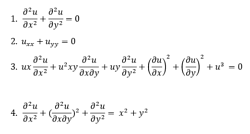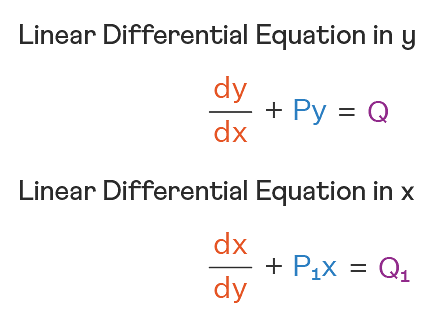Let S be the sample space of all five digit numbers. It p is the probability that a randomly selected number from S, is multiple of 7 but not divisible by 5, then 9p is equal to
Let S be the sample space of all five digit numbers. It p is the probability that a randomly selected number from S, is multiple of 7 but not divisible by 5, then 9p is equal to
- 1.0146
- 1.2085
- 1.0285
- 1.1521
The Correct Option is C
Solution and Explanation
The correct answer is (C):
Among the 5 digit numbers,
First number divisible by 7 is 10003 and last is 99995.
⇒ Number of numbers divisible by 7.
= \(\frac{99995-10003}{7} + 1\)
= 12875
First number divisible by 35 is 10010 and last is 99995.
⇒ Number of numbers divisible by 35 =\(\frac{ 99995-10010}{35}+1 = 2572\)
Hence number of number divisible by 7 but not by 5
= 12857 – 2572
= 10285
9P =\( \frac{10285}{90000} × 9\)
= 1.0285
Top Questions on types of differential equations
- If \( m_1 \) and \( m_2 \) are the slopes of the direct common tangents drawn to the circles \[ x^2 + y^2 - 2x - 8y + 8 = 0 \quad \text{and} \quad x^2 + y^2 - 8x + 15 = 0 \] then \( m_1 + m_2 \) is:
- TS EAMCET - 2024
- Mathematics
- types of differential equations
- If \( (2,3) \) is the focus and \( x - y + 3 = 0 \) is the directrix of a parabola, then the equation of the tangent drawn at the vertex of the parabola is:
- TS EAMCET - 2024
- Mathematics
- types of differential equations
- If the focus of an ellipse is \((-1,-1)\), equation of its directrix corresponding to this focus is \(x + y + 1 = 0\) and its eccentricity is \(\frac{1}{\sqrt{2}}\), then the length of its major axis is:
- TS EAMCET - 2024
- Mathematics
- types of differential equations
- The equation of the common tangent to the parabola \(y^2 = 8x\) and the circle \(x^2 + y^2 = 2\) is \(ax + by + 2 = 0\). If \(-\frac{a}{b}>0\), then \(3a^2 + 2b + 1 =\)
- TS EAMCET - 2024
- Mathematics
- types of differential equations
- The axis of a parabola is parallel to Y-axis. If this parabola passes through the points \( (1,0), (0,2), (-1,-1) \) and its equation is \( ax^2 + bx + cy + d = 0 \), then \( \frac{ad}{bc} \) is:
- TS EAMCET - 2024
- Mathematics
- types of differential equations
Questions Asked in JEE Main exam
Designate whether each of the following compounds is aromatic or not aromatic.

- JEE Main - 2025
- Aromaticity & chemistry of aromatic compounds
- In the Claisen-Schmidt reaction to prepare dibenzalacetone from 5.3 g benzaldehyde, a total of 3.51 g of product was obtained. The percentage yield in this reaction was _____.
- JEE Main - 2025
- Reaction Mechanisms & Synthesis
- Consider a completely full cylindrical water tank of height 1.6 m and cross-sectional area 0.5 $ m^2 $. It has a small hole in its side at a height 90 cm from the bottom. Assume, the cross-sectional area of the hole to be negligibly small as compared to that of the water tank. If a load 50 kg is applied at the top surface of the water in the tank then the velocity of the water coming out at the instant when the hole is opened is : (g = 10 $ m/s^2 $)
- JEE Main - 2025
- Fluid Mechanics
- If \[ \int_{-\frac{\pi}{2}}^{\frac{\pi}{2}} \frac{96x^2 \cos^2 x}{1 + e^x} dx = \pi(a\pi^2 + \beta), \quad a, \beta \in \mathbb{Z}, \] then \( (a + \beta)^2 \) equals:
- JEE Main - 2025
- Integration
- The value of \( (\sin 70^\circ)(\cot 10^\circ \cot 70^\circ - 1) \) is:
- JEE Main - 2025
- Trigonometric Identities
Concepts Used:
Types of Differential Equations
There are various types of Differential Equation, such as:
Ordinary Differential Equations:
Ordinary Differential Equations is an equation that indicates the relation of having one independent variable x, and one dependent variable y, along with some of its other derivatives.
\(F(\frac{dy}{dt},y,t) = 0\)
Partial Differential Equations:
A partial differential equation is a type, in which the equation carries many unknown variables with their partial derivatives.

Linear Differential Equations:
It is the linear polynomial equation in which derivatives of different variables exist. Linear Partial Differential Equation derivatives are partial and function is dependent on the variable.

Homogeneous Differential Equations:
When the degree of f(x,y) and g(x,y) is the same, it is known to be a homogeneous differential equation.
\(\frac{dy}{dx} = \frac{a_1x + b_1y + c_1}{a_2x + b_2y + c_2}\)
Read More: Differential Equations